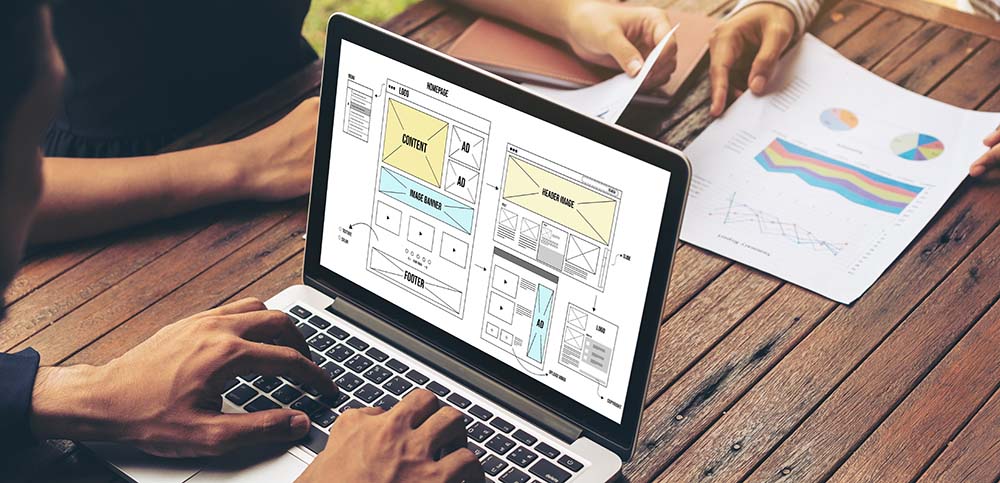Impress with an Effective Homepage
Your website’s homepage plays an important role. It’s the first impression of your business’ digital space. It also doesn’t have a lot of time to provide that introduction. The average user stays on a webpage for only 5.94 seconds and they judge it in only 1/20th of a second. As a result, your homepage needs to be purposefully designed to create a proper impression quickly. For that, it needs to look good, communicate effectively, and motivate your visitor to stay and use your site. Our website design team has the first steps so you can start building that impressive and effective homepage.
Who Are You?
Your homepage should clearly and concisely present what your business is and does. Name and display your main services or top products as the central thing visitors first see as they land on your homepage. They will immediately understand your business and see its products/services. This should also come with a short description that identifies your business’ name and what it does. First-time visitors to your site will not be familiar with your business. Use this opportunity to provide that information and show off your value proposition.
Navigable
Along with explaining who you are and what you can provide your visitors, you want to make it immediately clear how they can navigate your site for more information or products. Link the central images and descriptions to the appropriate dedicated pages so visitors can access them. The top should include a navigation bar with clear categories and page titles, so users know where to look and find what they are interested in. In addition to being a directional aid throughout your website, the navigation bar will quickly impress any visitor with the contents of your website, allowing them to understand its contents and services more quickly. Furthermore, your homepage will regularly be the return point for browsing. This easy navigation will ensure customers can readily move to the next page that interests them.
Calls To Action
Another aid to navigation that also helps keep a visitor interested is a call to action (CTA). Common examples are a prominent button in the middle of the page or in the navigation bar with a unique, contrasting colour. These will encourage your visitor to go beyond the homepage and guide them through your website’s main pages. The most common examples are “Shop Now”, “Learn More”, “Contact Us”, “Book a Consultation”, or “Request a Quote”. These short, simple instructions will also help a visitor immediately contextualize the products/services your website provides.
Newsletter or Contact Form
Presenting your visitor with a pop-up of a newsletter signup or contact form is an additional call to action that will keep your visitor connected to your website. These allow customers to learn more about your business, stay connected and return, and might include a discount as an incentive to purchase from you.
Do not present this pop-up right away. Allow your customers to get their impression of your homepage and maybe browse a bit before prompting them with signing up to their newsletter or suggesting they provide contact information. An immediate popup will prevent them from seeing your informative homepage and come off as pushy. Why would they sign up for a newsletter or want to contact you before they know who you are?
Less is Better
Not overwhelming your visitor is essential. Minimalism is a hallmark for designing your website’s homepage. A homepage with too much text, images, video, or CTAs will only confuse or frustrate your visitors. Just like when first introducing yourself, stick to the essentials and be concise for a good first impression. Provide a single large image, a short blurb, and one CTA that shows the essentials of your business. Not every visitor will have the same interests about your business, so it is best to provide the basics and have them navigate deeper in for what they want. Additional details should be placed in their own dedicated pages that visitors can easily access through the navigation bar or calls to action.
Optimized for Multiple Devices aka Responsive
A proper first impression means your website needs to function properly on various devices, particularly computers and mobile devices. As of this month, over 60% of web traffic comes from mobile devices. Your homepage needs to inform your visitor, allow direct navigation, and provide direction easily and elegantly on all of those different devices. If a visitor arrives on your homepage and not everything is visible or navigation is cumbersome or impossible, they will be left with a poor impression of your business and leave.
Adaptable
Your homepage should adapt to how visitors use and browse your website. Monitor website traffic to determine where users are going. If a specific service or product page is more popular, highlight it more immediately. This will sooner impress future visitors with the information they want. Remember you have less than 6 seconds. For example, if customers typically browse your new product page, it is a good strategy to link the “Shop Now” CTA to that page. Running user experience (UX) tests of your homepage and website will help you discover such potential site traffic patterns as well as unintended obstacles. Ever heard of heatmapping? Ask us about it!
Home is Where the Heart Is
Your homepage is the heart of your website. It introduces your business, directs visitors, and acts as the regular return point for browsing. It also does not have a lot of time to impress your visitors to stay and start exploring the deeper chambers of your website. These essentials will help guide you to create a homepage that gives the proper impression and welcomes your visitors. If you are looking to redesign or update your homepage to give your business the proper introduction it deserves, contact Rosewood’s website design team.




Leave a Reply
Want to join the discussion?Feel free to contribute!